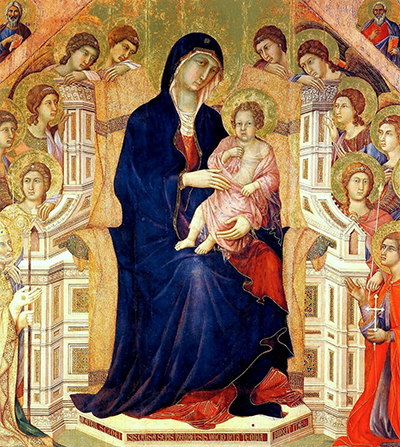Duccio di Buoninsegna was an Italian artist from the late 13th and early 14th century who rose to prominence in the cultural Tuscan city of Siena. He specialized in religious depictions and made a number of important artistic innovations.
This significant Sienese painter took the qualities of Byzantine art and incorporated a more natural look to his figures. His use of gold leaf paint brought an energy and brightness to Duccio’s paintings, whilst remaining focused on the religious themes which dominated European art for centuries.
His use of wooden panels rather than fresco art has ensured that a number of his works have survived to the present day, helping us to better understand the role that he played in bridging the Byzantine and Renaissance artistic periods.
Early Life
The artist was born in Siena at some point between the years of 1255-1260, though even with extensive research into the artist’s life, it has not been possible to be more precise than that. He achieved his artistic success in and around Siena, traveling to other locations in Tuscany in order to take on a number of commissions, most of which would be for government and religious institutions. In terms of his apprenticeship, the most likely route that he would have taken into professional life would have been under the wing of respected artist, Cimabue.
Most artists at this time would be trained in this manner, helping out in a master’s studio for a number of years, slowly being granted greater authority and responsibility as their skills progressed. Little documentary evidence supports this connection to Cimabue, but similarities in terms of artistic style and their respective locations at the time make this the best educated guess. Both artists were highly significant in moving Italy towards the Renaissance era, when the medium of painting would be rejuvenated.
Personal Life
The few accounts that we have of his life appear to suggest that Duccio was a chaotic figure in his personal life, building up considerable debts which may have brought him into conflict with his friends and family.
There's more information remaining on incidents related to this than to his artistic life, but thankfully a number of paintings from his career have survived to the present day, allowing us to form our own judgements on his work. It is believed that Duccio married and had many children, but this has not been verified beyond a single source.
Style and Technique
Prior to the influx of oil painting from Northern Europe during the Renaissance, Italian artists would concentrate on the use of egg tempera and fresco techniques. Duccio himself only used the former, as far as we can tell, but his focus on this approach allowed him to truly master its intricacies.
Indeed, many consider his technical ability to have followed the approach of Cimabue, but ultimately outshone him over time. This is reflected in the relative fame that their respective oeuvres achieved. Duccio regularly incorporated gold leaf paint into his egg tempera works and this helped to bring a bolder impact to his work, and avoid having blander sections in his compositions.
Such were the needs of his donors, his content would focus on episodes and passages from the Bible, with these themes dominating Italian art for several centuries after his passing. Wealth was concentrated in just a few hands at this time, and so artists would have little flexibility in deciding what they could feature in their work. It was also quite a privilege for any artist to be able to work without financial pressures in their own life, and so few would complain about this situation.
In terms of influence, we cannot offer concrete conclusions over where Duccio’s style originated. Most conclude that his use of gold leaf paint came from Byzantine art, as it was also fairly common there too. Indeed, some have even suggested that he may have spent some time studying in Constantinople, where the artist would have come into direct contact with these methods. Others have claimed that he may instead have visited the likes of Paris, Assisi and Rome during the formative period of his career.
In other aspects of his work, though, Duccio evolved the Byzantine approach, giving greater depth and lifelike qualities to his figures. He would also compose some of his more complex works in a manner which suggested careful planning, and perhaps prior sketching. Angles and use of architectural touches also evolved, laying the foundations for the Renaissance era in which many advancements would be made. His impact would therefore influence the next generation of artists who would take his ideas and evolve them further, before passing the baton onto those who followed.
Masterpieces
Duccio’s most famous paintings would have to be Rucellai Madonna (1285) and Maestà (1308–1311), which roughly mark the beginning and end of his artistic evolution. The latter offers a more ambitious approach, with a two sided altarpiece with extraordinary detail throughout.
The figures are noticeably more natural in appearance, and the complex composition has also been carefully laid out. By contrast, the Rucellai Madonna is not as polished, suggesting Duccio was still mastering his craft in the mid-1280s, whilst also displaying considerable potential at this stage. Additionally, as his confidence grew, Duccio would implement touches of architecture and other features which added more interest to his paintings and also moved away from the flatter nature of the Gothic style.
Death
Duccio died at some point between the years of 1318–1319, and would have been in his late fifties or early sixties at the time. His family rejected him soon after, because of the debts that he had accrued over his lifetime but his artistic legacy remained strong. A number of Italian art schools used his style as the basis for their own work and many of his ideas would become baked into the standards of Tuscan art over the next few centuries.




